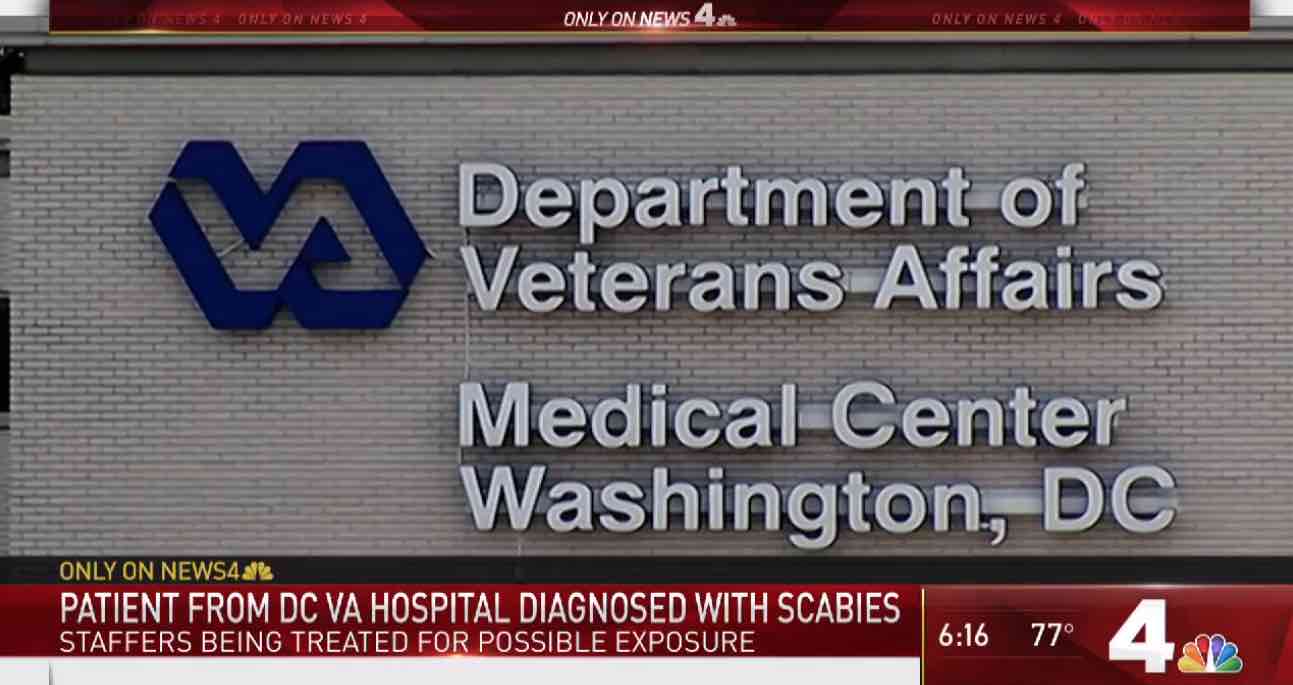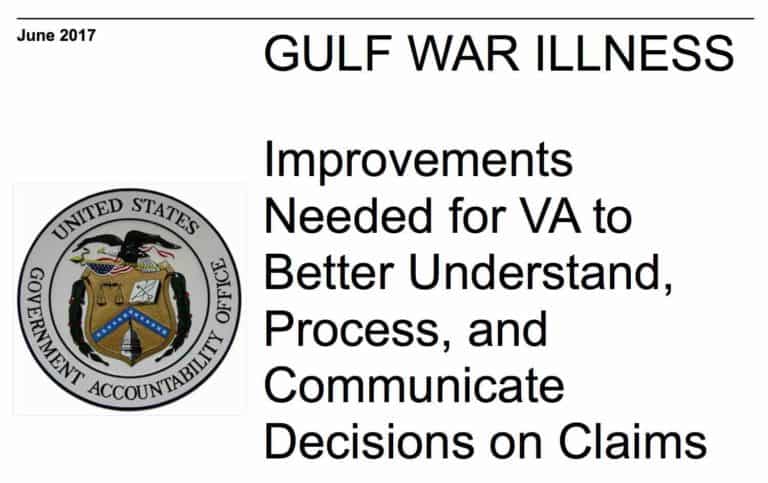More Than A Dozen Impacted By Scabies At VA Medical Center
Medical teams have ordered precautions to prevent the spread of scabies at Washington DC VA Medical Center after thirteen reports surface.
The facility is still operational while clinicians sort out how best to address the problem. Residents, staff, and their families are working with the clinicians since at least 12 were potentially exposed. The agency says only one patient was affected.
VA would not confirm if the employees had confirmed scabies cases.
Scabies is a highly contagious parasite that can live on the skin for months. The mite burrows into the skin to lay eggs resulting in itchy, red rashes. The mites can be transmitted by touching skin, clothing, or bedding.
The Washington DC VA Medical Center has been rife with problems for the past few years generally involving dirty equipment, dangerously low levels of supplies, and poor management.
RELATED: Blast From 2017
IG Report Summary Problems
In summary, the facility:
- Failed to keep a normal supply of required supplies and equipment to perform the lifesaving services expected of all major VA medical centers
- Failed to use proper protocol to remove recalled supplies and equipment to not put veterans’ lives at risk.
- Failed to ensure supplies were sterile but instead using dirty supplies.
Missing Supplies And Equipment
Here are the full bullet points on missing supplies and equipment:
- At the time of our site visit, the Medical Center was in the process of conducting a patient safety review because sterile processing ran out of supplies to test the insulation of scopes used in laparoscopic or endoscopic procedures. This testing is used to detect holes in the insulation surrounding the scopes that may result in the transmission of electrical current into surrounding tissues. If this occurs, patients may develop burns or latent infections. The Medical Center could not verify whether this testing had been done on scopes used in approximately 20 procedures since February 28, 2017-March 16, 2017.
- As recently as March 15, 2017, the Medical Center ran out of bloodlines for dialysis patients on the second shift—they were able to provide dialysis services to those patients only because staff borrowed bloodlines from a private hospital.
- On March 29, 2017 a nurse emailed the patient safety manager, reporting that during an acute episode, she needed to provide oxygen to a patient. The floor was out of oxygen nasal cannulas (tubing that fits into a patient’s nose and provides oxygen). The nurse was able to use one found on the crash cart, but reported the shortage as a risk to patient safety.
- On March 29, 2017 a vendor loaned bone cements to cover two total knee replacements for surgeries scheduled that week. Operating room staff requested that prosthetics purchase the bone cement, but was told the company could not deliver it until the next week.
- On March 30, 2017 the dialysis unit ran out of dialyzer bloodlines and 15 gauge fistula needles, both of which are essential for dialysis treatments.
- On April 4, 2017 staff inspected the storeroom on the floor that had run out of the oxygen nasal cannulas. Between 11 a.m. and noon, OIG staff determined the storeroom was out of alcohol pads; slipper socks/aqua shoes; denture cups (plastic containers used to store patients’ dentures); and large tegaderms, a type of wound dressing. OIG was informed that nursing staff inventoried the rooms three times a day, and sent requests to logistics to replenish stock as needed. However, when OIG staff returned after 6 p.m. on the same day, only the alcohol pads had been replenished.
- On April 5, 2017 the lead sterile processing technician had been tasked with finding a clip applier for use in a procedure scheduled to occur the next day. A clip applier is a device that deploys surgical clips that may be used to close off blood vessels or other tubular structures. OIG staff accompanied the technician as she searched for the device in the sterile processing department and in the central supply room. Despite having the purchase order number for the device, she was unable to find it.
- On April 11, 2017 received an email stating that the operating room (OR) ran out of vascular patches, despite having requested the assistance of the Deputy Chief Medical Officer of VISN 5 in obtaining them two weeks ago. The OR also ran out of Doppler probes. Nursing staff stated that the ORs could not form emergent or elective open vascular surgery without those in stock.
- On April 11, 2017 received an email stating that the OR ran out of sequential compression devices (SCDs). These are devices placed on patients’ legs to prevent blood clots during surgery. Surgery proceeded without the devices.
Long-term Supply Problem
VA OIG later determined the above problems existed for some time:
- Since January 1, 2014, the Medical Center has recorded 194 patient safety reports relating to the unavailability of equipment or supplies.
- In February 2016, a Stryker bone tray used in surgeries to repair mandibular (jaw) fractures had been removed from the facility due to outstanding invoices from the vendor. Surgical staff informed us that a procedure had to be delayed as a result.
- Four prostate biopsy surgical procedures were canceled on April 25, 2016 because prostate biopsy guns were out of stock. A nurse wrote an email to the medical center director on April 26, 2016 recommending an OR “stand down” until the operating room’s inventory situation could be remedied.
- In June 2016, the Medical Center discovered that one of its surgeons used expired surgical equipment on a patient during a surgical procedure. The Medical Center determined that the lack of an inventory management program caused the error. Rather than undertake measures to implement an appropriate inventory program, the Medical Center elected to require its nursing staff to conduct monthly rounds to identify and remove any expired supplies.
- On March 16, 2017, the facility found Sterrad chemical indicator strips that expired on February 28, 2017 in sterile processing. The indicators are placed with equipment and change colors when exposed to hydrogen peroxide. This allows a visual verification that sterilization occurred. The Medical Center could not determine whether the expired indicators had been used on some of the 396 items sterilized in the Medical Center between the date of the strips’ expiration and the date staff discovered the expired strips and removed them from the facility.
Dirty Supplies
IG also found VA was mixing clean supplies with dirty supplies:
- Eighteen sterile storage areas were dirty.
- Five sterile storage areas mixed clean with dirty equipment or supplies.
- Eight sterile storage areas contained supply racks lacking solid bottom shelves as required to reduce cross-contamination from the floor.
- Seventeen sterile storage areas lacked a method to monitor pressure, temperature, and humidity.
- Five sterile storage areas were cluttered.
- Five sterile storage areas improperly served multiple purposes including office and patient care space. These areas also lacked security and appropriate environmental controls.
Are We Surprised?
The facility can’t quite seem to get a handle on basic facility management. Every few years, VA has a scabies problem. The last one I could find in the news was 2011.







AOC needs to be treated in one of the VA medical facilities under an asumed named so she can really see how the VETS are treated like GARBAGE by the VA staff and Drs., maybe then she will shut the hell up on issues she knows nothing about. She’s a Millennial with Entitlements that has done nothing in this life but rob the rest of us of AIR, shes a waste of space.
According to AOC we have wonderful health care. Lol
Yep this is our health care an we should be greatful?
Our congressmen and women need to have this as their medical facility, of course they don’t care as we are no longer needed.
When I was having, my second cancer operation, “my sentinel lobe biopsy” done ( to remove my cancerous lymph nodes) when I had stage four cancer in 2016 the Gainesville VA medical center, said it “was out” of the nuclear medical dye that they use as a tracer and the surgery had to be delayed until they could obtain it from the manufacturer because they had none in supply and were unable to borrow it from any of the two other hospitals in our area. I found that answer to be ridiculous since we have one of the largest cancer hospitals in the southeast literally located across the street from the VA. Shands Cancer center where I still receive treatment after the VA botched the Sentinel lobe biopsy.
Wow, think it may be a good thing for VA to screw with me until I went to Mayo!
Damn it! Just when I was trying to let my guard down and give the VA a lil o bit of credit. I know it is a complicated issue trying to manage the VA Healthcare and Benefits System but that is what people are getting paid to do. Damn it – do your job and stop making things difficult when then haven’t any reason to be so. Just saying – ughrr.
Peace out
Veterans who reads this did War Time Service or even you didn’t bug the Senators or Representative contract the Veteran Affairs Committee your belief how to improve Veterans Health Care no excuse like Senators or Representative don’t listen.
You are a Whitehead. You are a Douche-Bag. You are illiterate. You are a phony.
U.S. Marine Corps Cpl. Arnold H. Cabral, from Wrightsville, N.C. and Modesto, Calif., respectively, was assigned to Georgian Liaison Team-9, during Operation Northern Lion in Mohammadabad, Helmand province, Afghanistan, June 24, 2013. Northern Lion was a Georgian-led operation conducted to deter insurgents, establish a security presence, and gather human intelligence in the area.
Arnold Cabral served this nation with honor. Have YOU ever stopped to think that maybe his TBI may affect his written skills?
Semper Fi, Arnold.
VAMC DC has always had problems despite being located near the VA Central Office. Why? Political appointees?
The D.C. VHA has been rife with egregious health benefits for years. Here’s an idea to get it cleaned up. ALL of Congress, both houses, and all government employees in Washington are now required/forced to use that VHA for their healthcare.
Let’s see some real reporting after some of our elected officials die off because of poor single payer socialist VA healthcare!
I wonder for the poor souls infected with this parasite from this clinic, is the VA going to pick up the tab to treat the entire families of these veterans in order to prevent reinfection? If not, that could end up costing the veterans a significant amount of out of pocket expense.
You have to know that this is just the tip of the iceberg. After all, the 1800 veterans that were potentially exposed to HIV and Hepatitis due improper sterilization procedures at the Saint Louis, MO. VA a few years back, under the stellar leadership of RimaAnn Nelson began with “only a few” reported cases. As I recall, she was ‘punished’ for this transgression by being given a transfer to the Manila Clinic, then when the scandal died down – – – she was given the Directorship of the Phoenix VA, and a hefty pay raise. A position she still holds today.
Nothing but the finest for our nations veterans . . .
@Catherine – – – Tried to reply to you WRT to your project, but comments were closed out. Publish a burner e-mail addy for me to get in touch.
VA Canteen Cafeteria Special Of The Day:
Purchase a 4 yr enlistment with a desperate signature only and you’ll get our AFGE manatee employee’s very special scabies soufflé with a side salad of crab lice and and a large glass of tepid sepsis to wash it all down from a VA water fountain, and garnished with a cloud of operating room flies.
**scabies are incredibly hard to get rid of, like the AFGE**
I’d wager scabies are more beneficial and contribute more to nature than parasites called AFGE.